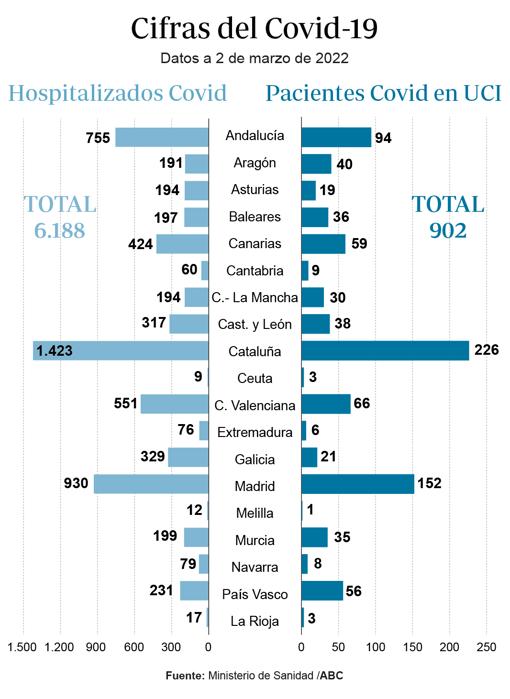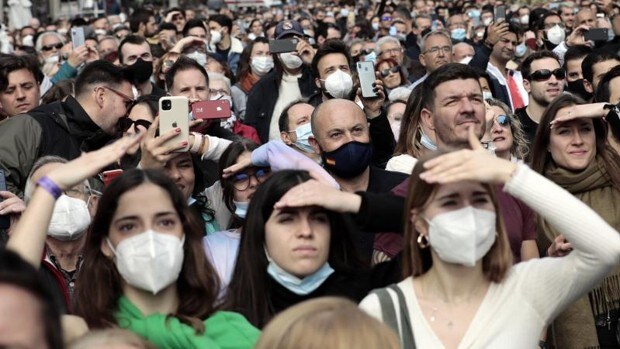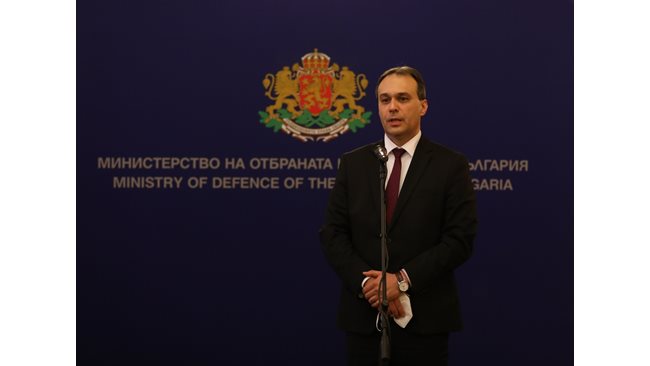Madrid
Keep
Two and a half months later, the accumulated incidence falls below 500 cases per hundred thousand inhabitants in the last 14 days. This Wednesday, the Ministry of Health has placed the rate at 486 cases, now standing at a high risk level; Far is that record reached on January 21, when it reached 3,418. The number of infections has also been drastically reduced, going from around three hundred thousand positives between report and report to fifty thousand.
After the arrival of Ómicron in Spain, despite registering maximum numbers in incidence and infections, hospitals and the number of deaths, thanks to the vaccine, have hardly suffered.
Thus, currently 6,188 people remain admitted to hospitals, and their overall occupancy is 13.04% per hundred thousand inhabitants. A year ago around these same dates, twice as many people needed hospital care (11,754).
Of all these cases, in the lead in terms of hospital pressure, although much less pronounced than in other pandemic waves, Asturias stands at 19.04% and 194 admitted patients, according to the latest report published by the Ministry of Health. behind, in Catalonia –one of the communities in which hospital occupation has been most stressed–, those admitted amount to 1,423 people, which represents an occupation of 18.29% of the beds. At the Hospital de Sant Pau in Barcelona, for example, there are 30 patients who remain on the ward and 4 who are in semi-critical care. No one there needs surveillance in the ICU. In the most complicated time of the pandemic, they had 100 critical patients. At Hospital del Mar, 42 people currently need this type of care, when in the worst time of the pandemic patients reached 900, according to reports Alex Gubern.

On the opposite side, with 5.31% are the hospitals of The Rioja, in which 17 people are still receiving health care. According to sources from the Health Service of Castilla la Mancha (Sescam), all the hospitals in the region “have already fully recovered their usual activity.” There, the occupation is 9.49% and the infected treated are around two hundred and only 30 patients need a respirator.
In this context, the Minister of Health, Carolina Darias, announced this Wednesday after the meeting of the Interterritorial Council of the National Health System (CISNS) that next Thursday, March 10, the autonomous communities will address together with Health in a meeting to be held in Zaragoza the new global health surveillance strategy. As explained by Darias, this document has not been updated since 2011, and will address “the transition to the new surveillance system for the new Covid”, since “the current situation is on the right track and we are making adequate progress.”
Thus, Health confirmed yesterday its intention to introduce a change in the coronavirus monitoring strategy. Starting next week, the daily vaccination report will be published weekly. And from the next one, which begins on March 14, the daily data of those infected and deceased by Covid published by the Center for the Coordination of Health Alerts and Emergencies will be published twice a week.
Shared Claim
The autonomous communities had already spent several weeks – six since the sixth wave began to descend – demanding that Health take a further step and establish a roadmap that allows the mask to be progressively removed in other closed spaces and that its use is limited, little by little. little, to crowded places such as public transport. This is already done in other European countries such as Ireland, Denmark or France. Not surprisingly, the President of the Government himself, Pedro Sánchez, confirmed that progress would soon be made in this matter “when the scientific evidence corroborates it”, and several communities asked yesterday at the meeting with Health for the removal of the mask in the classrooms.
Last February, when the incidence of the virus began to decline, Madrid was already the first region to start the debate within the Interterritorial Council. The Minister of Health of the Generalitat of Catalonia, Josep Maria Argimon, explained earlier this week that he hoped that the mandatory use of the mask indoors can be lifted in between “three weeks and a month”, once this measure is applied. in school classrooms after the decrease in the indicators of the pandemic.
The aspiration of the Andalusian counselor, Jesús Aguirre, is that after Easter they have disappeared from the classrooms and there is a normal situation. Thus, the Spanish Association of Pediatrics (AEP), through its Working Group for the Reopening of Schooling, already proposed in the middle of last February a calendar for the progressive removal of masks in school buildings.
From the Spanish Association of Epidemiology, its vice president, Oscar Zurriaga he does not believe it is opportune that the classrooms be used as a test site for this new strategy. “Nothing should be done if the data does not support it; when something is done, it has to be done with all the consequences that this entails », he explains. In this sense, the right time will come “when the incidence of the virus drops more than what the data says right now; when serious cases decrease, those admitted to the ICU and also the number of deaths », he adds.
–

